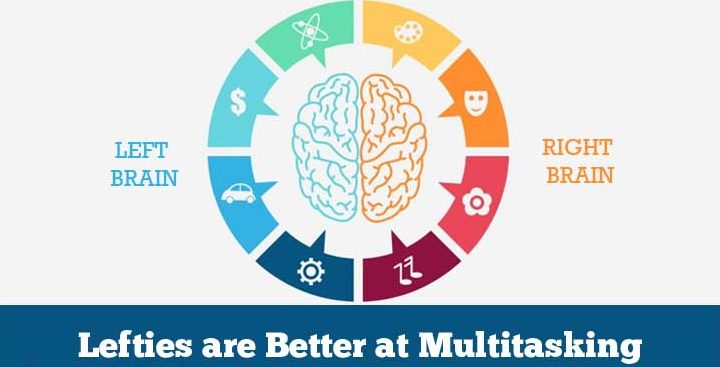What are the Truths about being Left-Handed?

Handedness, the preference of using a hand for usual tasks, starts with the dominance of the right or left brain. Left-handed people have a dominant right brain and the right-handed people have a dominant left brain. The four types of handedness are left-handedness, right-handedness, mixed-handedness and ambidexterity. Most of the people are right-handed, about 10% of the population in the world are left-handed.
Mixed-handedness is the change of hand preference between tasks. Ambidexterity is being able to do any task equally well with both hands, which can be learned through guidance and practice.
Most individuals are right-handed, which means that their left brain is more dominant than the right. The left brain also controls language in right-handed people. Speaking and handiwork require fine motor skills, and usually, the side of the brain that controls these two is the dominant one. Based on this theory, we can safely assume that lefties have a reversed brain division of labour.
Verbal processing takes place in the left hemisphere and the visuospatial processing is done in the right. Further, right-handed people have an organized division of labour. The left-handed individuals have a heterogeneous brain organization wherein both hemispheres may be used for verbal processing.
How handedness develops in humans has been a mystery, with only theories coming up to explain the reason.
Genetic Factors: Although handedness has shown a complex inheritance pattern, there has been evidence of a 26 per cent chance of a child being left-handed if both parents are. However, identifying a gene or set of genes that determine the laterality of the brain has not been possible.
Vestibular Asymmetry during Prenatal Period: The position of the fetus in the third trimester and the baby’s birth position can affect handedness.
History has provided evidence of people being left-handed, and this minority has faced a lot of prejudice, embarrassment, and even aggression. However, more recent findings indicate pleasant coincidences and advantages that lefties have over the right-handed majority. Some such interesting facts about left-handed people are listed below.
Lefties are Smarter: Left-handed people make up a disproportionately large part of the intelligent population. A possible theory is that the use of both sides of the brain helps in processing a large amount of information. The left hemisphere processes analytic and verbal style of thinking and the right one is associated with a holistic, creative style.
See Better in Water: This fact is based on the findings of many studies, although the reason for the connection is not very clear. A possible explanation could be that lefties tend to process information based on visual stimuli.
Better at Multitasking: The conversations between the left and right hemispheres seem to be processed faster in people who are left-handed and this ability has been found to increase with the increased dominance of the left hand. Lefties can easily deal with a large, unorganized stream of information.

Lefties have Better Memories: Most of the left-handed people have better memories and can remember the exact dates of events, and sometimes, even the exact words that were spoken. Better memories have been observed in people who are right-handed but belong to a family that has many lefties.
Better at Playing Video Games: Quick reflexes, dexterity and fine motor skills together contribute to their skill in killing zombies, playing virtual tennis or fighting off the monsters in the video games.
Lefties have an Advantage in Interactive Sports: Most of the right-handed players practice against right-handed counterparts and when they face the lefties, they are not ready. This is advantageous for left-handed players who can overcome right-handed and left-handed players easily.
Good at Art: Since left-handed people are inclined towards visual information than language-based, they tend to be more artistic and creative.
Lefties Find it Easy to Learn Driving: Equipped with the ability to multitask, the lefties find that the changing of the gear, turning of the wheel and applying breaks, all at the same time to be an easy job. A poll at the driving school found that 57% left-handers passed their driving test first time as compared with 47% of their right-handed counterparts.
Recovery from Stroke is Better in Left-Handed People: Lefties have been using both sides of the brain and this could be the reason that left-handed stroke survivors can recover faster than the right-handed survivors of stroke. Most lefties can use their non-dominant hand and this can also be the reason for the speedy recovery.
Earn Better than Right-Handed People: Research reveals that left-handed males who have attended college earn 13 per cent more than their right-handed counterparts. However, among women, lefties earn five per cent less than their right-handed peers.
On the flip side, lefties have some disadvantages too.
Lefties are more worried about making mistakes, more sensitive to criticism and are easily embarrassed. However, this link may also be due to their being a minority in the right-handed society.
Lefties are quick to anger. Some studies show that left-handed people showed an imbalance in processing emotions with their left and right hemispheres of their brain.
Left-handed people have a higher risk of brain disorders like schizophrenia, dyslexia or hyperactivity disorders.
Most of the tools, procedures and almost all the vehicles are designed to be used by the right-handed persons. Apart from facing this inconvenience, left-handers often face unfair discrimination and have been considered unlucky or malicious for their unusual laterality. Many of them were forced to use the right hand for purposes such as eating and writing.
During recent years, left-handedness has been recognized as a unique trait. Left-handers are not forced to use their right hands. Their creativity, uniqueness and their ability to do things in their own way have been recognized.
International Left-Handers Day is celebrated on August 13 every year. Many left-handed friendly products are launched, and awareness of the advantages and disadvantages are spread among the general public. Further, activities are also held for the right-handers to try out the products made for the lefties to create awareness about problems the latter group of people faces.
source:medindia.net




